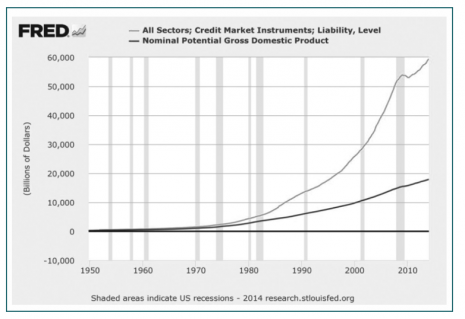Negative Interest Rates And Your Retirement
 If you are wondering how we got here with negative interest rates, here is a chart that gives a hint. GDP is, unfortunately, the lower curve. This is for the U.S. but this is now universal.
If you are wondering how we got here with negative interest rates, here is a chart that gives a hint. GDP is, unfortunately, the lower curve. This is for the U.S. but this is now universal.
Negative interest rates are a bizarre concept to say the least. They violate a basic principle of human action: a dollar today is better than a dollar tomorrow. We ask for a premium to lend money because of inflation ahead (ever present with our beloved central banks) and also because of the higher risk of not getting your money back the further in time you lend money. The premium or interest rate is related to time preferences of individuals and firms.
As Ludwig von Mises demonstrated in his famous 1920 essay, “Economic Calculation in the Socialist Commonwealth”, socialism is irrational. Central banking is the socialized version for money; it is also irrational. Irrational systems produce negative interest rates. In theory, the Keynesians at the helm of central banks are not that phased by this because it plays directly into their worldview that saving is evil. We have a clear winner: no savers left behind!

Now, negative interest rates are not so much about an actual policy; they are about fear. In Europe in particular, big money is scared so they park their money in what is perceived as guaranteed return of their money: government bonds (not so much a return on their money). They are paying for insurance and storage, which in practice makes sense; this is the equivalent of money in a vault (or so they think). More than US$12T (July 2016) of the world sovereign debt is yielding negative rates. Swiss bond yields are now negative out to 50 years. Investors now pay Germany to borrow for 10 years. Remember the PIIGS (Portugal, Ireland, Italy, Greece, and Spain) in Europe? Investors are now paying the PIIGS to borrow more money. Talking about capital consumption! This is like a black hole where productive capital goes to die. Productive capital is what grows economies. This will eventually hurt equities.
This is official policy with the ECB which is charging banks 0.4 percent (June 2016) to hold their cash overnight. Sweden, Switzerland and Denmark have also adopted negative rates. According to our Keynesians in power, the idea here is to spur lending by banks, jolt inflation and grow the economy. It has not worked, and it will not work if individuals and investors are scared and don’t want to spend or borrow. Add the problems of 360B euros (1/5 of Italy’s GDP) of non-performing loans in the Italian banking system and negative rates in the Eurozone will be the least of their worries. The FED ended their QE programs in 2014 and rates have fallen. No need for central banks to inflate at the moment to keep rates low on government bonds—fear is achieving this.
What else are negative interest rates not good for? The most conservative investment of all: life insurance. From The Wall Street Journal (April 2016):
“German regulators are so concerned about the impact of negative interest rates on the country’s life insurers that they have said they can only be sure the sector is safe through 2018. Even today, half the industry would be short of capital without the help of special measures.”(http://www.wsj.com/articles/german-life-insurers-feel-pain-of-negative-rates-1460547975)
Negative yields are the result of 8 years of zero interest rate policy (ZIRP). The real pool of wealth generation has been impaired so badly that it is reflected in the long-term rates: big money is running for cover in government bonds. The lon- term yields are still positive in the U.S. and Canada. This is before the next recession. Individuals will get used to negative yields at the bank as they will pay for insurance/storage too: FDIC and CDIC. There is no free lunch after all. Joe Smith may get currency out but if he spends it (rather than hoards it), it will go back to the banking system anyway. Big money can’t get currency out of the banking system and they represent the bulk of the deposits.
Central banks are trapped. The FED can’t hike “rates”. This is all Kabuki theatre. The only rate directly controlled by the FED is the fees paid on excess reserves (0.5%). Why hike that rate and push an already weak economy into the abyss and be blamed for it? Good thing the FED had Brexit to blame in June for a non-hike! Moreover, the FED has to pay those fees from their profits on maturing long term bonds (which usually go back to the Treasury). It is going to be interesting to see where they will get the money when those bonds turn negative. The FED funds rate is close to zero because banks have US$2T in excess reserves parked at the FED. Commercial banks are not lending. (Some recovery!) This is why, even with all the recent QEs, price inflation is not in the double digits: banks prefer putting their money at the FED earning 0.5% instead of lending into the economy. This is stopping the fractional reserve banking process in its tracks. The FED is actually pursuing a hard money policy—something that is rare.
In the next crisis, the Fed, as always, will rescue the big banks (no big banks left behind!) and will inflate. This should be good for gold. The other things that will go up are government bonds (yields down) and government deficits. Keynesians will have their higher deficits (low price: more is demanded) but this will not lead to an economic revival. The risk going forward to assets in bubble territory (real estate, for example) is not rising rates but people losing their jobs.
Negative rates will make it very hard to live on passive income. Now, retirees have to become “investors” and/or “entrepreneurs”. And they better pray for a good jolt of price deflation. Nevertheless, it seems retirees are already adjusting to this new reality as they stay more and more active in the workforce: employment rate for Canadians 65 and older was 8% in 2005 but is 13% in 2015. This doesn’t have to be a bad thing. Who said your potential is gone at 55 or 65? Who says you can’t serve your fellow man for a couple more decades? Freedom 55 was just off by a couple of decades.
Marie-Josée Loiselle, BEcon, MPA, President,
MJ Economics,Montreal, QC (514) 574-6641,
mariejo@mj-economics.com,www.mj-economics.com

